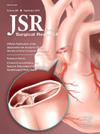When Is Old NOT Gold? Identifying Global Age Risk Surgical Thresholds to Improve Outcomes
IF 1.7
3区 医学
Q2 SURGERY
引用次数: 0
Abstract
Introduction
Patient age has been shown to influence health-care outcomes; however, there is limited evidence on the optimal cutoff where age increases the risk of adverse outcomes. This study aims to identify the age at which patients undergoing surgery in Pakistan can be classified as high-risk using the modified frailty index which can help in preoperative risk stratification, optimizing surgical outcomes, and guiding clinical decision-making.
Methods
American College of Surgeons National Surgical Quality Improvement Program data of adult patients undergoing major elective surgeries from 2019 to 2022 were used. High-risk patients were identified using the modified frailty index tool with a score of 2 and above. A receiver-operator curve (ROC) was used to determine the optimal age threshold for high-risk patients. Cox proportional regression identified hazard ratios for low and high-risk patients.
Results
A total of 10,060 surgical patients were identified. The optimal age threshold was 52.595 years (sensitivity: 79%, specificity: 72%, area under the curve 0.72). An age of 52.595 years and above was the high-risk group. The postoperative mortality was twice in the high-risk group compared to the low-risk group (2.95% & 1.11%; P value<0.001). All postoperative complications were higher in the high-risk compared to the low-risk group (27.01% & 19.28%). Case acuity and postoperative cardiac complication were significantly associated with mortality in low- and high-risk group.
Conclusions
Our findings indicated that age was associated with adverse outcomes in surgical population. Determining this age threshold in low- and middle-income countries is crucial for improving surgical outcomes via targeted interventions.
什么时候老不是金子?确定全球年龄风险手术阈值以改善预后
患者年龄已被证明会影响保健结果;然而,关于年龄增加不良后果风险的最佳临界值的证据有限。本研究旨在利用修正后的脆弱指数确定巴基斯坦手术患者的高危年龄,从而帮助术前风险分层,优化手术效果,指导临床决策。方法采用美国外科学会国家外科质量改进计划2019 - 2022年接受重大选择性手术的成年患者的数据。采用改进的衰弱指数工具识别评分在2分及以上的高危患者。采用受试者-操作者曲线(ROC)确定高危患者的最佳年龄阈值。Cox比例回归确定了低危和高危患者的风险比。结果共发现手术患者10060例。最佳年龄阈值为52.595岁(敏感性79%,特异性72%,曲线下面积0.72)。52.595岁及以上为高危人群。高危组术后死亡率是低危组的两倍(2.95% &;1.11%;P value< 0.001)。高危组术后并发症发生率均高于低危组(27.01% &;19.28%)。低危组和高危组的病例敏锐度和术后心脏并发症与死亡率显著相关。结论年龄与手术人群不良反应相关。确定低收入和中等收入国家的这一年龄阈值对于通过有针对性的干预措施改善手术结果至关重要。
本文章由计算机程序翻译,如有差异,请以英文原文为准。
求助全文
约1分钟内获得全文
求助全文
来源期刊
CiteScore
3.90
自引率
4.50%
发文量
627
审稿时长
138 days
期刊介绍:
The Journal of Surgical Research: Clinical and Laboratory Investigation publishes original articles concerned with clinical and laboratory investigations relevant to surgical practice and teaching. The journal emphasizes reports of clinical investigations or fundamental research bearing directly on surgical management that will be of general interest to a broad range of surgeons and surgical researchers. The articles presented need not have been the products of surgeons or of surgical laboratories.
The Journal of Surgical Research also features review articles and special articles relating to educational, research, or social issues of interest to the academic surgical community.

 求助内容:
求助内容: 应助结果提醒方式:
应助结果提醒方式:


